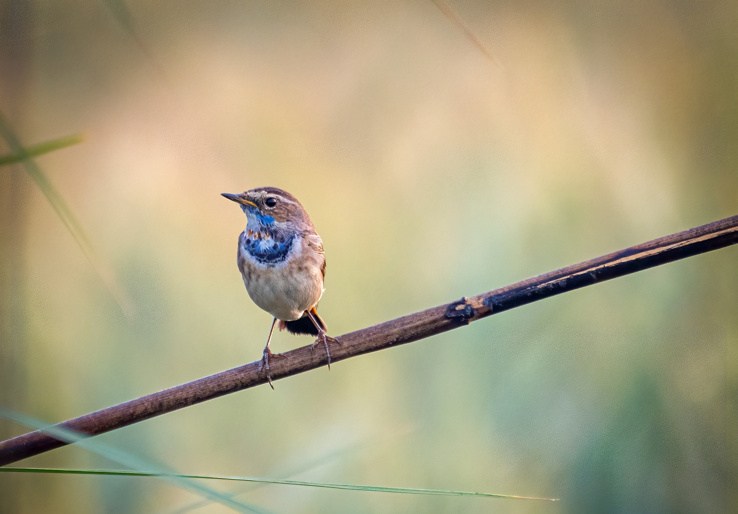Across the Sultanpur plains near Gurgaon in Haryana, farmers and their huge combines have been busy harvesting the winter wheat crop. At harvest time, the tall stalks spread till the horizon like a golden ocean, covering hundreds of hectares. The majesty of those "amber waves of grain" has long been an inspiration, not only to farmers but also to legions of photographers. The tiny water droplets on blades of grass and leaves can make fascinating subjects for creative photography.
This was the idea when we reached the fields on a misty morning last Sunday for a photoshoot. And then we saw a little bird playing hide in seek among the crop. We stood still and suddenly the bird perched on the top of the wheat stalk giving us a great pose in the sun rise.
A few days back, we had met the bluethroat at the Keoladeo Birds sanctuary in Bharatpur, Rajasthan but this one was a perfect frame.

The bluethroat is a type of sparrow and is known by different names in different countries. In Sweden it’s a passerine bird and known as Swedish Nightingale. In India it is called Neelkanthi In Hindi and Gujarati, Neelgola fidda in Bengali, Shankar in Marathi.
The bluethroat is a striking, beautiful species whose focal point is its clear, bright-blue bib or apron, which is underscored by two stripes – one rust-coloured and the other black. As is typical among birds, it is the male bluethroats that display more extravagant plumage than their female counterparts, whose throats do not feature this blue patch. It was like the bird was wearing a “naulakha necklace’.
Bluethroat usually skulk in low dense shrubbery, but sometimes a male will perch conspicuously to sing. It even sings in brief flights above the thickets. The song is variable, often including imitations of other birds. The male bluethroat has an impressive repertoire and pleasant sounds. His colouring is on full display and songs a mix of metallic sounds, repeated musical phrases and imitation of other birds.
The bluethroat’s usual call is a hard “tuck-tuck” or “tchak-tchak”, and also a plaintive “hweet”. The loud and varied song includes much mimicry of other species. Rich and sustained, the song includes bell-like notes such as “ting-ting-ting”, and musical notes, hisses and trills. The colourful throat patch of males is prominently shown off in aggressive encounters between rivals, as well as in courtship.

It is easy to photograph the bird when singing and perching on branches. Interestingly after the female has laid eggs, the male stops singing.
The bluethroat (Lucinia Svecica) is a small migratory bird and comes to India in winter in October and leaves in March/April. I was told that this bird comes all the way from Alaska and how much time it takes to reach here considering despite its small size, it is capable of travelling up to 80-100 km per day.
Bluethroat breeds in northern Europe, Eurasia, western Alaska and Yukon Territory.
It winters mainly from north eastern Africa to western India, and in sub-Saharan Africa, from Gambia to Ethiopia, and Saudi Arabia. Winter areas in North America are unknown, but the species presumed to winter in SE China, crossing the Bering Strait. Bluethroat is an insectivore. It forages in low vegetation to catch insects. When on the ground, it turns over the leaves and the soil to expose small invertebrates. It may hawk flying insects too. It runs on the ground as a mouse. It remains hidden under cover. It has an erect attitude and may stay motionless for a moment.An abundant passage migrant in the Western Himalayas West of Nepal, Rajasthan, Andhra Pradesh and the dry regions of North India, ‘the bird is a regular winter visitor to Gulf countries and Iran. It prefers dry regions and shrub and thorny areas as its breeding place. The sighting must be an indication of the climate change and warming up of this region,’ says our guide.
In Hindi, this bird is known as Neel Kanthi, a literal translation of bluethroat. But this Neel Kanthi is different from the Indian Roller which is known as Neel Kanth.
Like Neel Kanth, Neel Kanthi too has a link with Indian mythology. It goes back to the Mahabharat era. During their exile, the Pandavas were hiding in a dense forest. One spring afternoon, Bheema, the strongest one of five brothers, was resting after his lunch. A snake bit him behind his ear and Bheema woke up feeling the pain. He saw the snake disappearing in nearby bushes. Suddenly, Bheema started feeling dizzy because of the snake venom and started losing his consciousness. According to the legend, a little sparrow with a red bib came and poked her pointed beak in the wound caused by the snake bite and began to suck out the venom.
Bhima was amazed at the kindness of the small bird trying so hard to save him. He was humbled that a tiny creature tried to save a mighty Pandava warrior. Suddenly the red patch at the bird’s throat turned blue and Bheema was horrified that the little bird which helped him was dying. Suddenly, a group of bulbuls hopped over the little bird and poured nectar into the throat of the dying sparrow. The nectar washed away the venom and the little sparrow strength revived slowly. The sparrow was able to stand and hop as usual. Bhima noticed that the bird was no longer red throated but had turned blue.
Bheema named the bird as Nil Kanthi as it had a blue throat like Mahadev. Hence the blue-throated sparrow is called Neel Kanth – Mahadev’s bird.




















